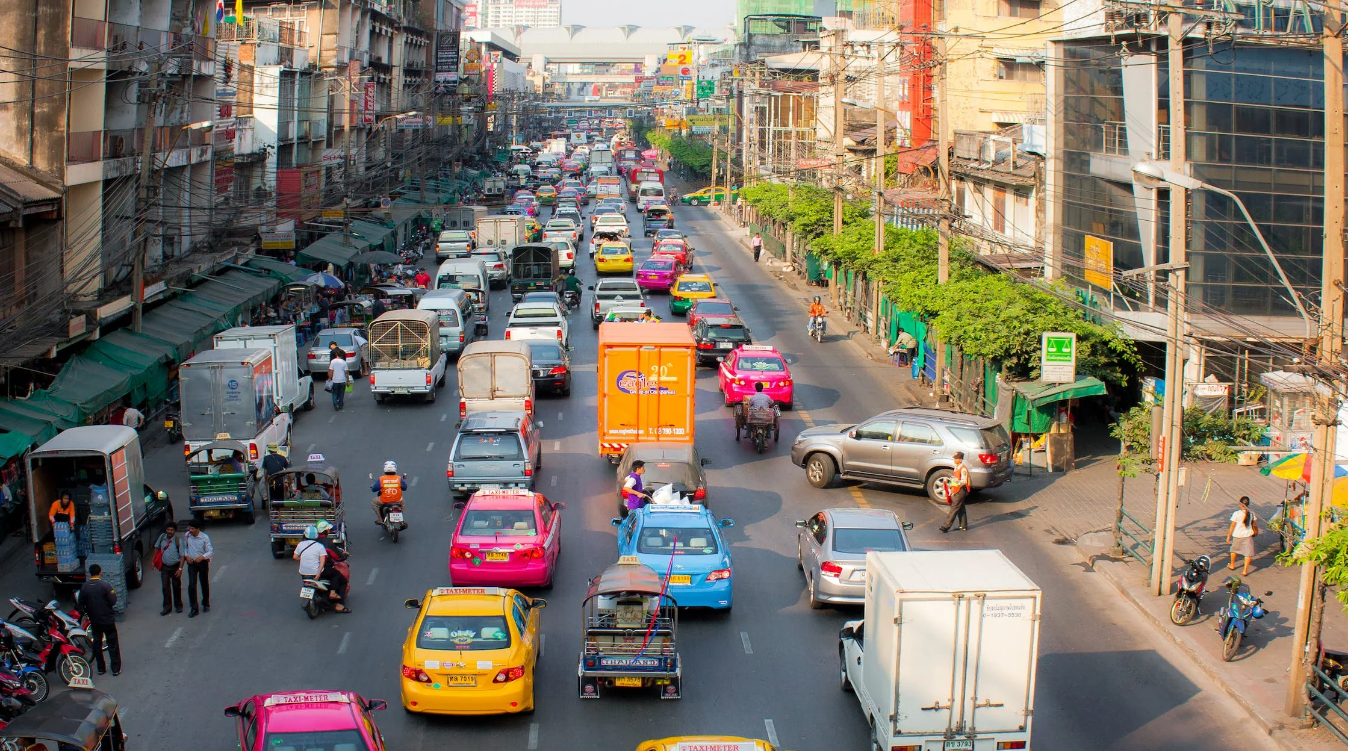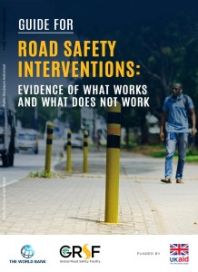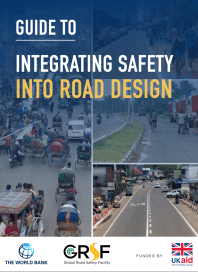
GRSF Supports 7th UN Global Road Safety Week
May 16, 2023
The World Health Organization and the United Nations regional commissions celebrate its 7th UN Global Road Safety Week from May 15-21, 2023. This year’s theme, #RethinkMobility, is a call to shift to sustainable modes of transport, in particular walking, cycling, and public transport. Road safety is both a prerequisite for and an outcome of this shift.
GRSF is marking UN Global Road Safety Week by promoting sustainable modes of transport and highlighting GRSF's work in the Philippines, Vietnam, Ethiopia and Bolivia promoting safe mobility for all road users.
Join us to advocate for safe walking, cycling, and public transport this week by using these hashtags on social media:
#GRSF #UNGRSW #RethinkMobility #RoadSafety
Messages from World Bank Leadership
GRSF asked leaders of the World Bank why road safety is a key priority. Watch the video below to hear what they had to say.
Featuring:
- Axel van Trotsenburg, Senior Managing Director, Development Policy and Partnerships (@ 0:11)
- Mamta Murthi, Vice President, Human Development (@ 0:36)
- Guangzhe Chen, Vice President, Infrastructure (@ 1:09)
- Nicolas Peltier-Thiberge, Global Director, Transport (@ 1:31)
- Jennifer Sara, Global Director, Climate Change (@ 1:56)
- Said Dahdah, Global Lead for Road Safety and Head of GRSF (@ 2:15)
Our latest blog: Rethinking Mobility
Global Road Fatalities Remain Unacceptably High. Rethinking Mobility is the Only Solution.
Senior Transport Specialist and GRSF Program Manager, Alina F. Burlacu, published a piece on the World Bank's Transport for Development blog. The piece argues that, if we are to significantly reduce the unacceptably high road crash fatality rate, we will need a new mobility hierarchy that prioritizes the movement of people above vehicles, and that values safety, sustainability, and inclusion above all else.

Speed Management Hub
#RethinkMobility FAQs
The GRSF Speed Management Hub provides evidence-based road safety knowledge to help manage speed through infrastructure interventions, effective enforcement, targeted awareness measures, and vehicle technology.
A key feature of the hub is an ever-expanding list of Frequently Asked Questions (FAQs) about speed management.
To the right are some FAQs related to sustainable transportation and the #RethinkMobility theme.
Frequently Asked Questions
Vulnerable road users such as pedestrians, cyclists or powered two-wheelers have a high risk of severe or fatal injury when they are hit by motor vehicles. This is because they are often physically completely unprotected or only have very limited protection, compared with the safety of a vehicle with a rigid safety shell and airbags.
The probability that a vulnerable road user will be killed if hit by a motor vehicle increases drastically with speed. If hit by a car at 30 kph, 10% of vulnerable road users die, another 15% are seriously injured and 75% are slightly injured. If the impact speed increases to 50 kph these numbers change dramatically: 80% die, 3% are seriously and 17% slightly injured.
The situation is even worse for elderly pedestrians. In fact, pedestrians over the age of 75 are twice as likely to be killed in a crash as those under 34. Elderly people are much more susceptible to injury if they are struck by a vehicle. Their bones are much frailer, and their overall state of health is worse – factors that can make even a minor crash turn lethal. Elderly pedestrians are also more vulnerable to being involved in a crash because of age-related declines in cognitive function and vision.
Children are also highly vulnerable to injuries from motor vehicle impacts. This vulnerability occurs for several reasons including that they have less developed cognitive and perceptual skills and so are less able to make decisions about safe behavior around traffic; the decisions they do make may be less predictable to other road users (such as running after a ball); they are smaller than adults, and so may be harder to see or be seen in traffic; and there is emerging evidence that they are more likely to suffer more severe injuries when struck as pedestrians (especially head injuries).
Under the Safe System approach (see Q1.2) the setting of speed limits considers the risks to road users of sustaining fatal or serious injuries. For example, at locations where there is a significant level of pedestrian or cyclist activity, lower speed limits are appropriate. Similarly, where the potential for conflicts is high (e.g., on busy urban roads with frequent points of access) speed limits are to be set at a level that will minimize the chances of fatal or serious injuries in the event of a crash.
You can learn more on this topic from WHO here, Vision Zero here or Australia here.
Network and town planning practices need to reflect the needs of vulnerable road users and enable the adoption of Safe System speeds. Three of the more relevant examples are discussed here, namely: A) the Dutch functional network structure, B) the Spanish superblocks, and C) 20-minute neighborhoods.
Since the late 1990s, the Netherlands has incorporated sustainable safety into the categorization and layout of its road network and town planning – this is called, functional network structure. Based on two main functions of roads and streets, namely: flow and access, three road categories are distinguished in the Netherlands:
- Through roads allow traffic to travel from origin to destination as quickly and safely as possible ('flow'). Through roads may only be situated outside urban areas.
- Access roads offer direct access to residential areas at locations of origin and destination.
- Distributor roads connect the through roads with the access roads. Distributor roads are found in both urban and rural areas.
Most relevant to vulnerable road users, ‘access roads’, provide access to homes, businesses, schools, hospitals, shops, etc. Access roads can be mainly found in areas with a residential function. This means that all types of traffic mix here: pedestrians, cyclists, motorcycles, cars, and trucks.
In urban areas, access roads have a 30 kph speed limit. In addition to 30 kph access roads there are home-zones. Home-zones have a 15 kph speed limit and pedestrians can walk and play on the entire width of the street.
The adoption of functional network structure has had a large impact on road safety in the Netherlands. Read more about it here.
Superblocks are neighborhoods of several blocks (e.g. 9 blocks in Barcelona) where through traffic is, completely or partially, banned. They are accessible to local and access traffic, and community and emergency services. However, speed limits are lowered to between 10 and 30 kph.
A new town planning paradigm, superblocks are shown to prevent premature deaths, improve air quality, promote physical activity and prevent public health issues, e.g., road trauma.
Superblocks are also effective planning measures to manage speed and improve vulnerable road user safety. By dropping speed limits to levels that are compliant with the Safe System approach, Superblocks allow people of various ages and capabilities to adopt an active lifestyle. Compared to a default speed limit of 50 kph, a superblock with a speed limit of 20 kph can be almost 90% safer for pedestrians and cyclists.
More specifically, assessing a superblock through the Kinetic Energy Management Model (KEMM) lens, we see that superblocks fulfil three important traffic safety functions: a) they reduce people's exposure to cars, b) they create an environment that is easier to navigate and understand, and where the intrinsic risk of crashes is lower, and c) any potential collision is likely to occur at lower speeds and not be severely injurious to pedestrians and cyclists. Read more about superblocks here and here.
A successful planning approach, the 20-minute neighborhood emphasizes the value of living locally and providing people with active transport options to meet as many daily needs as possible within a 20-minute walk from home, with safe cycling and walking facilities and local transport options. Embedded in strategic urban planning of many cities, the 20-minute neighborhood is a promising tool to deliver healthy and environmentally friendly environments while ensuring safety and speed management measures as well. Specifically, it helps us manage exposure to traffic risk for some of the most vulnerable community groups such as children, persons with disabilities, women and the elderly, and creates justification to reduce speed and provide better walking/cycling facilities. Find Melbourne’s plan for its 20-minute neighborhoods here, the Paris example here (a 15-minute city) and information from Bogota here.
There are several road safety engineering tools to manage speed to provide safer outcomes for pedestrians and cyclists. We divide them into midblock (road/street length) and intersection solutions (see also FAQ3.2).
Speed management tools at midblock
- Traffic calming measures: Traffic calming measures, both horizontal and vertical ones, are shown to help reduce speed to safer levels. Examples include traffic humps, platforms, road narrowing and chicanes. A comprehensive list is discussed in FAQ3.2.
- Raised pedestrian crossings (30 kph or lower): An effective traffic calming measure, raised pedestrian crossings are a pedestrian crossing placed on a flat top road hump. These should be designed to encourage a speed of not greater than 30 kph through ramp profile and crossing height. Not only does this provides pedestrian (and cyclist) crossing priority, but the raised platform gives further prominence to pedestrians and encourages motorists to slow down on approach to the crossing.
- Raised threshold platforms at side-streets and driveways: Pedestrians and cyclists crossing side-streets and driveways are at risk of being struck by entering/exiting traffic. By providing continuity of the footpath level (and/or bicycle lane) across the conflict area, the threshold design enhances safety for pedestrians/cyclists. Where there is high pedestrian and/or vehicle volumes, a pedestrian crossing can be added to strengthen pedestrian priority.
- Shared space or shared zone (10-15 kph): A shared space/zone is a street or network of streets where space is shared by vehicles and pedestrians and other vulnerable road users. Safety is a major priority and appropriate measures and rules are put in place to ensure these vulnerable users receive priority and are protected against vehicle movement.
Speed management tools at intersections
- Safety platforms (30 kph or lower): Extensively trialed and implemented in the Netherlands, safety platforms are specifically designed road humps that are placed on the approaches to intersections to reduce speed to desirable levels. They are shown to be effective speed management tools for both vulnerable road users and car occupants at intersections.
- Raised intersections (30 kph or lower): The incorporation of a raised intersection profile (or plateau) into an intersection design has the potential to be transformational in achieving Safe System risk levels, especially if designed to achieve 30 kph speeds. A variety of speed levels could be achieved with the appropriate degree of vertical deflection.
- Roundabouts with 30 kph raised pedestrian crossings: Urban roundabouts are Safe System aligned for vulnerable road users, provided they incorporate design features specifically for pedestrian and cyclist safety. This means that the approaching speed should be lowered to 30 kph or lower, and the use of raised pedestrian crossing on the approaching lanes is shown to work.
Read more about road safety engineering solutions to manage speed for pedestrian and cyclist safety in these documents by SWOV and Austroads.
In the late 1960s & '70s, the Netherlands was far from being an acknowledged leader in pedestrian and cyclist safety as it is today. Road deaths numbered in the thousands, and as documented in Road deaths in the Netherlands, hit a ceiling well above 3,200 per year. Cyclists, pedestrians, and children paid most of the price.
This triggered the historic ‘Stop de Kindermoord’ (literally "Stop the Child Murder" in Dutch) grassroots movement in the Netherlands. The success of this movement turned Dutch government policy around and the country began to restrict motor vehicles in its towns and cities and direct its focus on growth towards walking and cycling.
Since then, a large number of grassroots advocacy groups, established on similar lifesaving agendas, have emerged around the world, some of which are focused on speed management.
- 20's Plenty for Us is a 'not for profit' initiative with 500 local groups campaigning to make cities, towns, and villages around the world better places to be. They campaign for a default speed of 20 mph (30 kph) on residential streets and in town and village centers, without the need for physical calming. Local circumstances may make a higher limit appropriate on some streets, providing that the needs of vulnerable road users have been fully considered.
- Love 30 Canada is campaigning to make 30 kph the default speed limit for urban and residential streets. They state that no matter how safe vehicles, roads, and drivers are, all of these things will fail beyond certain speeds. Each road must be designed to have speeds that are in line with the injury potentials on each type of road in the event of a crash. The level of harm to vulnerable road users rises dramatically at speeds of higher than 30 kph, making this the sensible default limit for places where vehicles and people mix.
- 30please are campaigning for 30 kph speed limits to be the norm for neighborhood streets. They demand a strategy to create safe and connected walking and cycling network. They believe sharing existing streets by driving slowly on those that are not very important for cars is a sensible solution, not only from a cost perspective.
New Animation: Traffic Calming Measures
Traffic calming measures are an essential tool for improving road safety. Check out our latest video animation on the Speed Management Hub to learn more about how specific traffic calming solutions can be applied in different settings, such as in urban, suburban, and rural areas.





